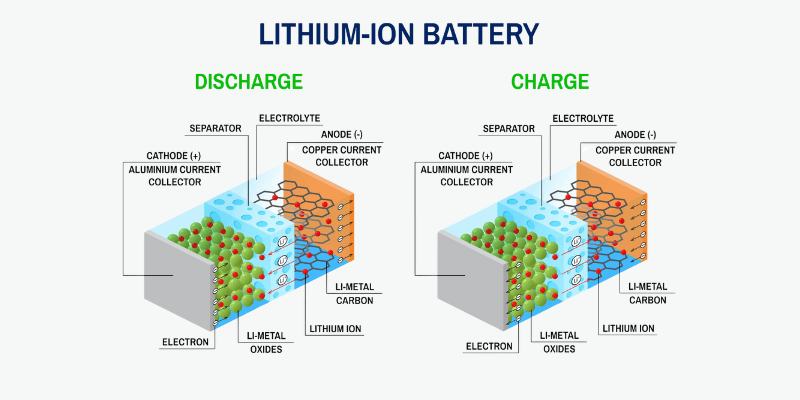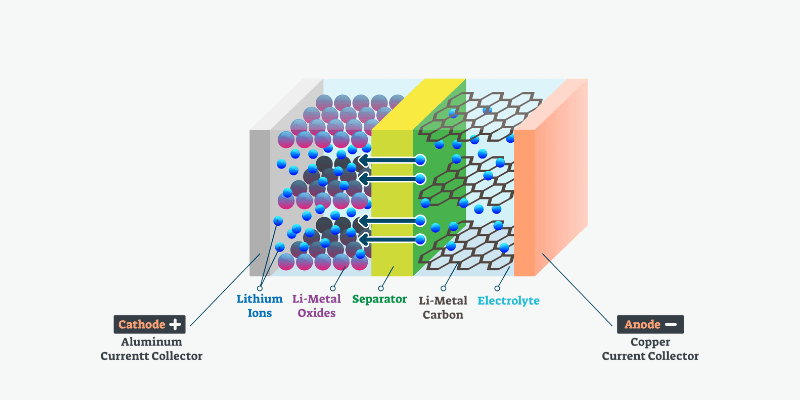Batteriets kraft är nu vanligt i våra dagliga liv, från smartphones till elfordon. En nyckelbatterikomponent är den interna elektrolyten, som håller dina enheter igång.
Idag, låt oss utforska vad batterielektrolyt är och hur det fungerar.
Vad är batterielektrolyt?
Batterielektrolyten är ämnet som transporterar positiva joner mellan batteriets två elektroder, vilket gör att batteriet kan ladda och urladdas. Elektrolyten kan vara en vätska eller pastaliknande substans, beroende på batterytyp.
Hur fungerar batterielektrolyt?
Ett batteri har Tre viktiga komponenter: katoden, anoden och en elektrolyt som separerar dem. Elektrolyten underlättar en elektrisk laddning mellan terminaler, vilket gör kemikalierna för att reagera och omvandla lagrad energi till användbar el för anslutna enheter.

Vad är batterielektrolyten gjord av?
Olika batterier förlitar sig på olika kemiska reaktioner och elektrolyter. Bly-syrabatterier använder svavelsyra, zink-luftbatterier oxiderar zink med syre, och alkaliska batterier använder kaliumhydroxid. Litiumbatterier använder vanligtvis en litiumsaltlösning, såsom litiumhexafluorofosfat, som elektrolyten.
Kan du lägga till elektrolyt i ett batteri?
Ja, du kan lägga till vatten till ett icke-förseglat våtcellbatteri. Använd emellertid endast destillerat vatten, eftersom batteriet konsumerar vatten, inte svavelsyra.
För förseglade eller icke-av-gasande batterier, såsom AGM eller litiumjon, kräver inte elektrolyttillägg. Deras brist på avgasning är en fördel, eftersom de behöver lite underhåll en gång installerat.
Vilka är ingredienserna i litiumbatterielektrolyter?
Litiumbatterielektrolyter varierar beroende på batterikemi och typ. De flesta använder en flytande elektrolyt som LIPF6, LIBF4 eller LICLO4 i ett organiskt lösningsmedel.
Fasta keramiska elektrolyter, såsom litiummetalloxider, är emellertid ett växande alternativ. Fasta elektrolyter eliminerar riskerna för läckage och brandfarlighet förknippade med flytande elektrolyter.
Litiumhexafluorofosfat (LIPF6) är det vanligaste litiumsaltet i litiumjonbatterier, vilket skapar en stabil miljö för litiumjoner under användning.
Är litiumbatteri elektrolyt säkert?
Tidiga litiumbatterier står inför termisk flykt och brandrisker på grund av överhettning, punktering eller överladdning. Men elektrolyterna är säkra.
När tekniken utvecklas kan nya säkerhetsfunktioner som Holo Battery's BMS upptäcka och stänga av osäkra celler, vilket gör sina batterier bland de säkraste tillgängliga.
Slutsats
Batterielektrolyt är avgörande för alla batterityper, men ofta förbises.
Att förstå hur det fungerar kan förlänga batteritiden, särskilt för vissa batteryper.
Att investera i produkter som Holo Batteris anpassade litiumjonbatterier kräver mindre underhåll, eftersom elektrolyten är mindre oroande.
Relaterade artiklar:

